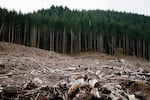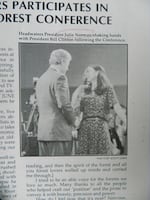
A clearcut left behind where an Oregon forest near Eugene was logged.
Wikimedia Commons
The Portland Convention Center is abuzz with activity. Security personnel and organizers chatter on walkie-talkies. Photographers and reporters pace the periphery. The audience is full of dignitaries; a who’s-who of Northwest politicians and public figures.
Then a voice – a cross between a game show host and debate moderator – fills the vast room.
“Ladies and gentlemen, the president and vice president of the United States.”
The applause comes slowly, with surprising hesitation, perhaps because no one really knows where this day - April 2, 1993 - is headed.
But there’s a sense this could be the beginning of a detente in the Timber Wars.
The “War in the Woods”
The 1980s and 1990s were an acrimonious time in the history of the Northwest.
The logging industry had been king for decades, at its peak cutting more than 15 billion board feet a year from private and public forestlands in Oregon, Washington and Northern California.
But an environmental awakening was occurring.
On drives back from guiding rafting trips on the Rogue River, Julie Norman saw first-hand an increasing number of clear cuts. She wanted to do something to stop the destruction she was seeing, so she joined a tiny Southern Oregon conservation organization called Headwaters.
“Neighbors were teaming up and forming these little grassroots groups, like ours,” she says.

Julie Norman testifying at the NW Forest Summit (left) and today (right) at her home in Ashland, Oregon.
Jes Burns/EarthFix
These grassroots environmental groups began launching administrative appeals against timber sales in the '80s. But they were slow to find success on their own.
“Luckily there were national groups that had organizations in the big cities like Portland and Seattle and Eugene, and they rallied. And then we all banded together,” says Norman.
At the same time, the direct action group Earth First! was taking its fight to the forests. Their activists sat in trees, blocked logging roads, disabled equipment, clashed with loggers and brought national attention to the issue by getting arrested at protests.
In 1990, the northern spotted owl was listed as "threatened" under the Endangered Species Act. This gave a new legal avenue for challenging timber sales in public forests. Norman says with the organizational, legal and financial backing of national groups, like the Audubon Society, the more mainstream conservation groups began making headway in the courts.
A year later, they won a resounding victory. A federal judge placed an injunction on all timber sales in spotted owl habitat until forest managers could produce a plan to ensure preservation of the entire ecosystem.
And just like that, new logging in the Northwest came to a standstill.
White House Intervention
In the years following, tensions remained high in the Northwest. The “War in the Woods” continued. Environmental activists maintained pressure on the Forest Service and BLM to ensure habitat protections for spotted owls and other old-growth dependent species. Anger towards these groups fomented in rural communities, which saw conservation of the spotted owl as a threat to their livelihoods and existence.
(Story continues below)
The media distilled the complex struggle down to a "jobs versus owls" dichotomy. The owl became seen as the poster-species of conservationists. In one instance in 1991, a dead owl was found nailed to a sign in Olympic National Park on Washington's Olympic Peninsula with a note vaguely threatening to burn down the forest.
Finally, in 1993, President Bill Clinton decided to intervene. He called for a Northwest Forest Summit in Portland.
“Clinton was like the grand facilitator. You know, he could have been a councilor or something,” says Norman who, as the President of Headwaters, was invited to participate. “I think he drew everyone out in a very congenial way as if he was trying to figure this whole thing out.”
In his speech to open the summit, Clinton set the tone by telling the crowd he wanted to move beyond confrontation and build consensus “on a balanced policy to preserve jobs and to protect our environment.”
He did this over the course of the day by bringing together environmentalists, timber representatives, scientists, fishermen, dockworkers and local government officials.
Before a national audience on C-SPAN, Norman made the case to stop logging old-growth forests. Others made their case to the president as well:
“"Essentially what we need the government to do is get out of the way. Let the market system work. Get some certainty in the West side timber supply." -- Walter Minnick – CEO, Veneer Firm, Future Democratic U.S. Representative from Idaho
"They have consistently allowed overcutting of those lands. And they have misled workers in timber-dependent communities into believing that that way of life can continue, and it can't." -- Vic Sher, Attorney, Earthjustice (then known as the Sierra Club Legal Defense Fund)
"Now where do we go from here? Wherever it is, it needs to be done very quickly." -- Dave Schmidt, Linn County, Oregon Commissioner
"What most scientists are advocating is an ecosystem approach to the management of all old forest resources." -- Charles Meslow, Oregon Cooperative Wildlife Research Unit, USFS ”
After several sessions of testimony and questions, Clinton delivered his marching orders. He directed his administration to start work on a new plan – balanced, comprehensive and designed for the long term.
A new plan
A year later, the Northwest Forest Plan emerged. It set the rules for 24 million acres of federal lands in the Pacific Northwest and promised to protect the forest environment while producing a predictable and sustainable level of timber sales.
On logging front it did not deliver.

A clipping from a Headwaters newsletter after the Northwest Forest Summit.
Jes Burns/EarthFix
The plan promised a timber harvest of about 1.1 billion board feet per year on public forests in Washington, Oregon and Northern California. This was an 80 percent reduction from original levels, according to the American Forest Resource Council.
“The plan has never met those expectations,” says Bob Ragon, the head of the Douglas Timber Operators. “It’s been dramatically less than that because of all the legal challenges that have been filed by the environmental groups.”
The actual logging levels have average closer to half the promised amount.
But as an old-growth habitat conservation strategy, the Northwest Forest Plan has been largely successful, says Norman.
“We might not have been happy with every aspect of it, but it was such a huge improvement over the past,” she says.
The plan has largely stood up in the courts, even as its poster-bird, the northern spotted owl, continues to decline - in part because of the encroachment of the barred owl.
A new plan?
The Forest Service is now beginning the process of updating the Northwest Forest Plan.
Officials are expected to release the 20-year status report early this summer, which will recommend improvements going forward. The Forest Service has started meeting with environmental, timber industry and other stakeholder groups. It has also hosted three public listening sessions in Portland, Seattle and Redding, California.
“We’re really at the very beginning,” says Forest Service spokesman Glen Sachet “There is no set roadmap in front of us.”
No roadmap ahead – maybe. But there is a long and rutted track behind that will be difficult to abandon. And if trends of the past hold, any gain for the timber industry will be seen as a loss for conservationists.